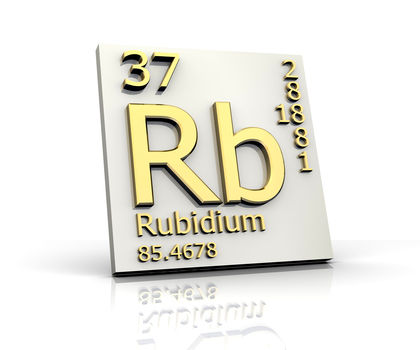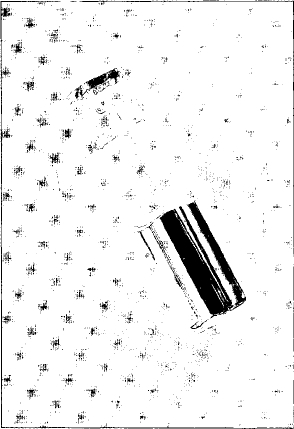RUBIDIUM


Overview
Rubidium is a soft, silvery metal. It is one of the most active chemical elements. Rubidium is a member of the alkali family. The alkali family consists of elements in Group 1 (IA) of the periodic table. The periodic table is a chart that shows how chemical elements are related to one another. Other Group 1 (IA) elements include lithium, sodium, potassium, cesium, and francium. Rubidium was discovered in 1861 by German chemists Robert Bunsen (1811-99) and Gustav Kirchhoff (1824-87).
Rubidium is used to make atomic clocks. An atomic clock is a device for keeping very exact time. A radioactive isotope of rubidium is also used to measure the age of very old objects. In general, however, rubidium and its compounds have few practical uses.
SYMBOL
Rb
ATOMIC NUMBER
37
ATOMIC MASS
85.4678
FAMILY
Group 1 (IA)
Alkali metal
PRONUNCIATION
roo-BID-ee-um
Discovery and naming
Rubidium is one of four elements discovered by spectroscopy. Spectroscopy is the process of analyzing the light produced when an element is heated. Every element produces a very specific series of colored lines called a spectrum (plural: spectra ).
Spectroscopy is a very useful technique for chemists. Sometimes only a very small amount of an element in a sample can be tested. And that amount may be too small to see or weigh easily. But the element can still be detected by heating the sample. The element will give off its characteristic line spectrum. The line spectrum shows that the element is present.
Bunsen and Kirchhoff used a spectroscope to find rubidium in a mineral called lepidolite. The mineral had been discovered in the 1790s by a Jesuit priest, Abbé Nicolaus Poda of Neuhaus, Germany (1723?-98). When Bunsen and Kirchhoff heated a sample of lepidolite, they found two new lines in the spectrum. This is what they reported:
The magnificent dark red color of these new rays of the new alkali metal led us to give this element the name rubidium and the symbol Rb from rubidus, which, with the ancients, served to designate the deepest red.
( See sidebar on Bunsen in the cesium entry in Volume 1.)
Physical properties
Rubidium is a soft, silvery metal. It has a melting point of 39°C (102°F) and a boiling point of 688°C (1,270°F). Its density is 1.532 grams per cubic centimeter.
Chemical properties
Rubidium is one of the most active elements. It catches fire when exposed to oxygen in the air. For that reason, it must be stored completely submerged in kerosene. Rubidium also reacts vigorously with water. It produces hydrogen gas which catches fire and bums. Rubidium combines violently with the halogens (fluorine, chlorine, bromine, and iodine).
Occurrence in nature
Rubidium is a relatively abundant element at about 35 to 75 parts per million. This makes it about as abundant as nickel, chromium, zinc, and copper.
The most common ores of rubidium are lepidolite, carnallite, and pollucite. Rubidium is also found in seawater and in mineral springs.

The chemists who discovered rubidium said it had a "magnificent dark red color." The name came from rubidus, which was a word once used to refer to "the deepest red."
Isotopes
Two naturally occurring isotopes of rubidium exist: rubidium-85 and rubidium-87. Isotopes are two or more forms of an element. Isotopes differ from each other according to their mass number. The number written to the right of the element's name is the mass number. The mass number represents the number of protons plus neutrons in the nucleus of an atom of the element. The number of protons determines the element, but the number of neutrons in the atom of any one element can vary. Each variation is an isotope.
Rubidium-87 is a radioactive isotope. A radioactive isotope is one that breaks apart and gives off some form of radiation. Some radioactive isotopes occur naturally. Others can be produced artificially by firing very small particles at atoms. These particles stick in the atoms and make them radioactive. About 16 artificial radioactive isotopes of rubidium have also been made.
Rubidium-87 is used to estimate the age of very old rocks. Many kinds of rocks contain two rubidium isotopes, rubidium-85 and rubidium-87. When rubidium-87 breaks down in the rock, it changes into a new isotope, strontium -87. Any rock that contains rubidium-87 also contains some strontium-87.
But rocks that contain rubidium usually contain strontium as well. One of the isotopes of strontium found in these rocks is strontium-86. It is not radioactive.
Consider a rock that contains both rubidium and strontium. It will contain two isotopes of strontium. One is naturally-occurring strontium-86, and the other is radioactive strontium-87, which is produced when the rock's rubidium-87 breaks down.
The amount of strontium-87 in the rock depends on how long it has been there. The longer the rock has been in place, the longer rubidium-87 has had to break down and the longer strontium-87 has had to form. But the amount of strontium-86 does not change. It is not produced by rubidium-87.
To determine the age of a rock, then, scientists measure the amount of strontium-87 compared to the amount of strontium-86. The higher the ratio of strontium-87 to strontium-86, the longer the rock has been in existence. This method for measuring the age of rocks has been used to measure the age of the Earth and the age of meteorites.
A radioactive isotope of rubidium, rubidium-87 is used to estimate the aqe of very old rocks.
Extraction
A common method for producing rubidium is to pass an electrical current
through molten (melted) rubidium chloride:
Uses and compounds
There are relatively few commercial uses for rubidium or its compounds. Rubidium is used to make atomic clocks. But these clocks are used only for very specialized purposes where very precise time-keeping is important. Rubidium is also used to make photocells. A photocell is a device for converting light energy into electrical energy. But other members of the alkali family are still preferred for this application.
One application of photocells is in motion detectors for security alarm systems. A beam of light is emitted by a special device so that it strikes the photocell precisely, producing a tiny electric current. If something or someone "breaks" (interrupts) the beam, the current stops flowing and an alarm sounds.
Health effects
No health effects of rubidium have been recorded. As a safety measure, chemists treat the metal as if it were toxic. They handle it with caution.